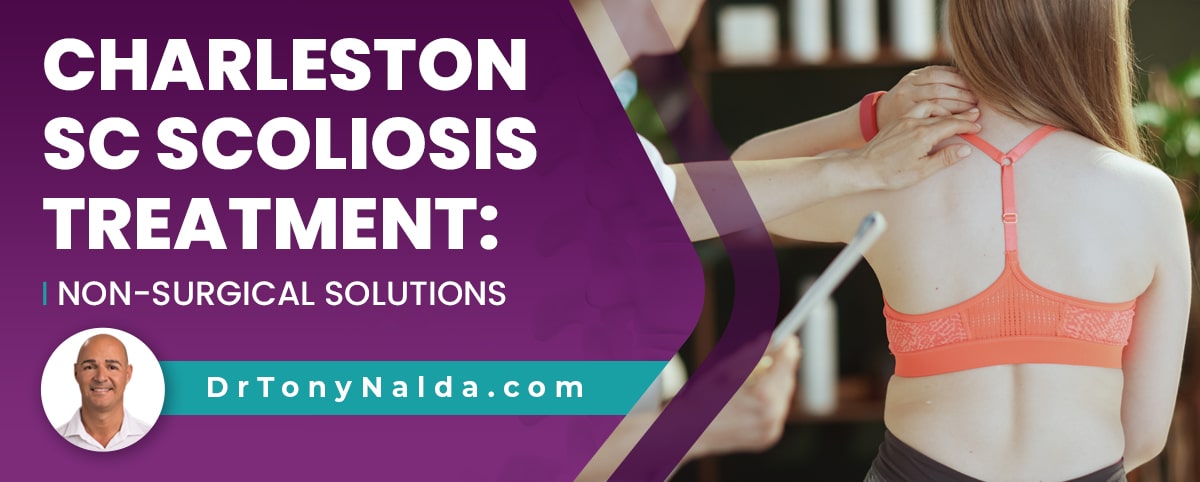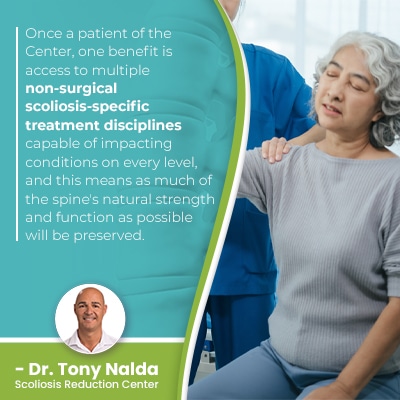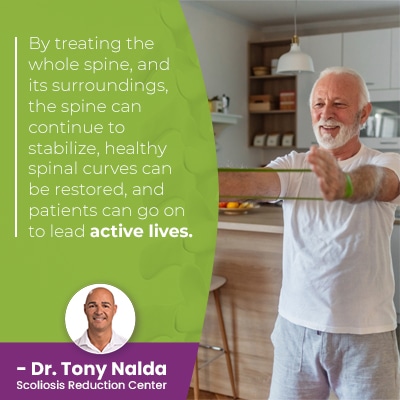Charleston SC Scoliosis Treatment: Non-Surgical Solutions

As a progressive condition, the most important decision to be made following a diagnosis of scoliosis is how it's going to be treated; this is important because how scoliosis is addressed will shape the spine's overall health.
For residents of Charleston SC, a 6.5-hour flight to Orlando, Florida can put them in reach of renowned scoliosis chiropractor, Dr. Tony Nalda, and his thriving non-surgical treatment center: the Scoliosis Reduction Center®.
For people with scoliosis, postural changes and pain can be common, and the best way to minimize these effects is to choose a proactive treatment approach.
Table of Contents
Proactive vs Reactive Scoliosis Treatment
When dealing with a progressive condition like scoliosis, sometimes when treatment is started can be almost as important as the type of treatment started.
Proactive treatment is started early in a condition's progressive line in the interest of preventing progression, and this is at the core of a conservative non-surgical treatment approach.
Scoliosis causes the development of an unnatural spinal curve that bends to the side and rotates, and progression means the size of the unnatural spinal curve is increasing, and this makes the condition more complex to treat.
Scoliosis will range in severity from mild scoliosis to moderate scoliosis, very and very severe scoliosis, and this is also the condition's progressive line.
The milder scoliosis is when treatment is started, the simpler it is to treat, hence the benefit of proactive treatment that's started as close to the time of diagnosis as possible.
Reactive Means Waiting
A reactive treatment approach is one that doesn't work towards prevention but is more about only responding to the condition with treatment once a certain severity level is reached, but this means doing little beforehand to prevent progression from occurring.
A reactive response characterizes traditional scoliosis treatment that commonly recommends watching and waiting while conditions are mild to see if they progress, but as a progressive condition, we know that virtually every case is going to progress at some point, so to me, this is wasting valuable treatment time.
While watching and waiting, conditions are being left to progress unimpeded, and this can lead to needing invasive spinal surgery in the future: something I want to help patients avoid.
While surgical treatment can straighten a bent and twisted spine, it can cost the spine in terms of its overall strength and function, and this can mean living with a spine that's weaker, more vulnerable to injury, and not as flexible.
Scoliosis Progression
 We don't always know what triggers scoliosis to develop initially, but we know that it's growth that makes it progress, and the most prevalent form of scoliosis overall is adolescent idiopathic scoliosis that affects adolescents between the ages of 10 and 18.
We don't always know what triggers scoliosis to develop initially, but we know that it's growth that makes it progress, and the most prevalent form of scoliosis overall is adolescent idiopathic scoliosis that affects adolescents between the ages of 10 and 18.
The danger of watching and waiting instead of being proactive with treatment is that a significant growth spurt can occur and cause conditions to progress rapidly; puberty makes adolescents vulnerable to rapid-phase progression.
While adults also experience progression, particularly older adults for whom spinal degeneration is a factor, because they have the progressive trigger of growth removed, treatment can be slower as rapid progression isn't a risk.
So while conditions are being observed passively, they can be progressing significantly, making conditions more complex to treat.
Scoliosis progression, however, can be preventable, which is what makes many cases of scoliosis highly treatable.
Non-Surgical Correction of Scoliosis
Non-surgical correction of scoliosis has a number of benefits, which is why it can be worth traveling to access the non-surgical treatment offered by the Scoliosis Reduction Center®.
A 6.5-hour flight from Charleston SC to Orlando, Florida can mean accessing the many different types of non-surgical treatment options the Center is known for.
Once a patient of the Center, one benefit is access to multiple non-surgical scoliosis-specific treatment disciplines capable of impacting conditions on every level, and this means as much of the spine's natural strength and function as possible will be preserved.
There are different types of scoliosis from idiopathic scoliosis to neuromuscular scoliosis, degenerative scoliosis, and congenital scoliosis, and one of the first steps of crafting a customized treatment plan is determining condition type, because type is determined by causation, and when known, a condition's underlying cause has to guide treatment.
For example, in cases of neuromuscular scoliosis, the scoliosis is caused by the presence of a larger neuromuscular condition such as cerebral palsy, spina bifida, and muscular dystrophy, so the neuromuscular condition has to be the focus of treatment, and this complicates the process.
Early Detection Can Help
While there are never treatment guarantees, with early detection and intervention, there are a number of treatment benefits, including treating a spine that's more malleable and a body that hasn't yet experienced a lot of the condition's effects.
Progression increases spinal rigidity, making the spine less responsive to treatment, and it can also make it difficult to perform key therapeutic exercises as part of treatment.
Patients of the Center benefit from a multifaceted approach that combines condition-specific chiropractic care, physical therapy, corrective bracing, and rehabilitation.
Can a Chiropractor Fix Scoliosis?
Most cases of scoliosis will respond to scoliosis-specific chiropractic care, and when combined with other types of corrective treatment, curvature reductions can be worked towards that address the condition's underlying structural nature.
A number of chiropractic techniques and manual adjustments can help adjust the position of the curve's most-tilted vertebrae so they are more aligned with the rest of the spine.
Reducing the unhealthy curve means restoring the spine's healthy curves and improving the spine's overall biomechanics.
Improving the spine's structure isn't enough; the spine's surrounding muscles also need to be strengthened.
Physical Therapy and Scoliosis Exercises
Physical therapy and scoliosis exercises can help restore muscle strength and balance.
Scoliosis is an asymmetrical condition that is associated with the development of a muscular imbalance; an unnatural spinal curve can pull the spine's surrounding muscles in different directions, causing the muscles on one side to become weak from underuse, while muscles on the opposite side have to work harder and can become stretched and sore from overuse.
Physical therapy can help strengthen the spine's surrounding weak muscles and relax the overused muscles for improved spinal support and stability.
Physical therapy and scoliosis-specific exercise can also improve posture and stimulate certain areas of the brain for improved brain-body communication.
Scoliosis Bracing
 Scoliosis bracing used at the Center is corrective; the ScoliBrace can help augment treatment by pushing the spine into a straighter alignment.
Scoliosis bracing used at the Center is corrective; the ScoliBrace can help augment treatment by pushing the spine into a straighter alignment.
As growing spines are more malleable, corrective bracing is used commonly when treating childhood scoliosis.
When treating adult scoliosis, bracing can be used for pain relief and improving the spine's stability.
Rehabilitating the Spine
Rehabilitating the spine properly is important.
As a progressive condition, scoliosis is incurable, so treatment is about managing an ongoing condition for the best quality of life.
Rehabilitation can be an ongoing process that includes leading a scoliosis-friendly lifestyle, continued chiropractic care, and custom-prescribed exercises patients can easily perform from home to continue healing and stabilizing their spines.
Scoliosis isn't always painful, but when it gets worse, it's likely to become painful, and this commonly involves the condition becoming compressive once skeletal maturity has been reached.
By treating the whole spine, and its surroundings, the spine can continue to stabilize, healthy spinal curves can be restored, and patients can go on to lead active lives.
Conclusion
For Charleston SC patients, a 6.5 hour flight to Orlando, Florida can mean accessing Dr. Tony Nalda's multifaceted conservative treatment approach; many travel from farther to become patients of the Scoliosis Reduction Center®.
And as such a popular vacation destination, Florida has much to offer patients during their stay in the Sunshine State while undergoing treatment.
The most important thing I want patients to know about scoliosis treatment is that the type of treatment chosen will shape how the spine functions in the future.
While traditional scoliosis treatment funnels patients towards invasive, costly, and risky spinal fusion surgery, the Center's approach offers a less invasive non-surgical treatment alternative.
The most important thing to understand about scoliosis treatment is that different types of treatment affect the spine differently, and as a progressive condition, treatment isn't about curing scoliosis but managing an ongoing condition for the best quality of life.
The Center's treatment results speak for themselves, and while no one treatment discipline is enough to address scoliosis on its own, when multiple corrective disciplines are integrated into a customized treatment plan, there are fewer limits to what can be achieved.
So if you, or someone you care about, is considering different treatment options to commit to, don't hesitate to reach out to discuss potions and/or to schedule a consultation.
Dr. Tony Nalda
DOCTOR OF CHIROPRACTIC
After receiving an undergraduate degree in psychology and his Doctorate of Chiropractic from Life University, Dr. Nalda settled in Celebration, Florida and proceeded to build one of Central Florida’s most successful chiropractic clinics.
His experience with patients suffering from scoliosis, and the confusion and frustration they faced, led him to seek a specialty in scoliosis care. In 2006 he completed his Intensive Care Certification from CLEAR Institute, a leading scoliosis educational and certification center.
About Dr. Tony Nalda
 Ready to explore scoliosis treatment? Contact Us Now
Ready to explore scoliosis treatment? Contact Us Now





